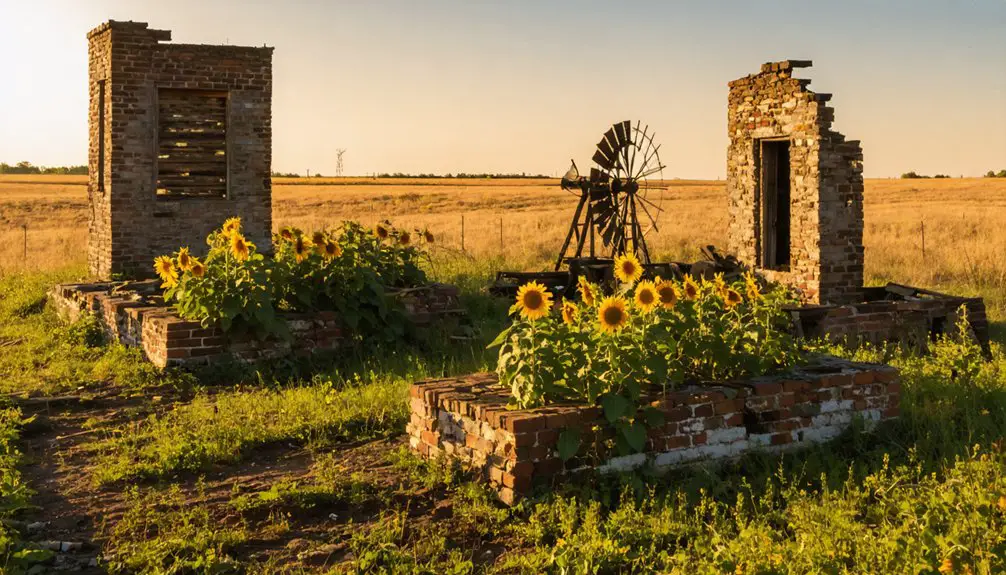You’ll find Crum Creek’s ghost town origins in Pushmataha County, Oklahoma, where the St. Louis and San Francisco Railway established a crucial spur in 1916. Located 14 miles southwest of Tuskahoma near the Kiamichi River, this small settlement operated a post office until 1927. The town’s brief but significant existence was shaped by railroad commerce and local timber trade. Its archaeological remains and oral histories reveal a deeper story of early 20th-century Oklahoma life.
Key Takeaways
- Crum Creek was established in 1916 near the Kiamichi River when the St. Louis and San Francisco Railway created a rail spur.
- Located 14 miles southwest of Tuskahoma in Pushmataha County, the town served as a vital transportation hub for timber shipping.
- The town’s post office operated from 1916 to 1927, marking the community’s active period before its eventual decline.
- Economic decline began with reduced railroad traffic and shifted toward truck transportation in the 1930s during the Great Depression.
- Archaeological remains include railroad infrastructure, while artifact recovery reveals Native American pottery fragments and projectile points.
The Rise of a Railroad Settlement
When the St. Louis and San Francisco Railway established a spur in Pushmataha County, Oklahoma, you’d have witnessed the birth of a promising settlement.
Crum Creek’s geography played a decisive role in its location, as the waterway’s natural path alongside the Kiamichi River provided an ideal setting for railroad development.
The railroad influences transformed this remote area into a connected hub, positioning it 14 miles southwest of Tuskahoma.
You would’ve found a bustling post office that opened in 1916, serving as the community’s lifeline to the outside world.
Early residents conducted short excursions along the creek to study and document the local flora and fauna.
The railway spur created crucial links between Crum Creek and major stops along the Frisco line between Clayton and Antlers, establishing essential transportation access that drew settlers and workers to this emerging community. Just as with the historic Leiper family railroad, this spur played a vital role in local transportation and development.
Origins of the Crum Creek Name
The origins of Crum Creek’s name trace back to a local resident who lived in the area during the early 1900s. While historical records don’t extensively document this resident’s background, their surname “Crum” became permanently linked to the local waterway and subsequent railroad spur. Long before European settlement, the Lenni Lenape tribe inhabited these creek lands and sustained themselves through agriculture.
You’ll find an interesting parallel in the Dutch meaning of “crum,” which translates to “crooked” and was commonly used to name winding waterways, particularly in Pennsylvania. The creek’s path stretches 24 miles southward before reaching its destination.
However, Oklahoma’s Crum Creek origins remain distinctly tied to the local resident rather than geographic features. The name gained official recognition when the Crum Creek Post Office operated from 1916 to 1927, serving the small railroad settlement in what was historically Choctaw Nation territory within Pushmataha County.
Life Along the Kiamichi River Valley
Since prehistoric times, life along the Kiamichi River Valley has flourished as an essential north-south corridor through Oklahoma’s rugged Ouachita Mountains.
Through ancient times to today, the Kiamichi River Valley remains a vital pathway across Oklahoma’s mountainous wilderness.
You’ll find evidence of rich Caddo culture stretching back 8,000 years, including a remarkable fish weir from 1200 BC that shows how early inhabitants mastered river ecology.
The valley’s unique landscape, shaped by dark shales and sandstone formations, created perfect conditions for settlement, with elevations reaching 2,500 feet in the surrounding Kiamichi Mountains. The area’s Tenmile Creek Formation consists of dark gray shales that weather easily, contributing to the valley’s distinct geological character.
You’d discover abundant wildlife here – from black bears and cougars to sacred bald eagles, all sustained by the valley’s 60-inch annual rainfall and numerous springs.
The river’s path later guided military roads and railroad development, weaving together centuries of human activity along this crucial waterway. The St. Louis and San Francisco Railroad transformed the valley between 1882 and 1887, bringing European American settlers to new railroad stations.
The Post Office Era: 1916-1927
Among the valley’s earliest postal hubs, Crum Creek Post Office emerged on February 9, 1916, serving residents along its namesake creek and the St. Louis and San Francisco Railway line.
For over 11 years, this crucial Postal Service facility connected the rural community to the wider world, processing mail for locals and railroad workers alike in Pushmataha County. Similar to how Roy Hoffman’s namesake established its post office in 1905, Crum Creek played a vital role in the region’s postal development. The rich historical significance of the area made the post office an important landmark for preserving local heritage.
You’ll find its strategic location southwest of Tuskahoma made it an essential Community Connection point during a time when Rural Free Delivery hadn’t yet reached many remote areas.
Named after a local settler, the post office operated until July 30, 1927, marking an important chapter in Oklahoma’s postal modernization.
During its operation, it stood as a symbol of progress and independence for valley residents, facilitating commerce and communication in this frontier region.
Railway Operations and Economic Impact
Operating as an essential artery of the St. Louis and San Francisco Railway system, the Crum Creek spur provided critical railway infrastructure to this remote area of Pushmataha County.
You’ll find that this 14-mile connection southwest of Tuskahoma played an important role in the region’s economic sustainability during the early 20th century. Like the historic first permanent railroad built by Thomas Leiper in 1809, this line was vital for transporting raw materials.
The spur’s primary function was facilitating shipments of local timber and agricultural products while supporting small-scale commercial enterprises. The Frisco line running between Clayton and Antlers formed the main connection to larger markets. It created jobs related to rail operations, loading, and resource extraction logistics.
The rural spur line drove local commerce through timber transport and created vital railway jobs in this remote region.
However, you can trace the settlement’s decline to the growing competition from trucking, limited population growth, and the rail company’s shift toward more profitable routes.
Once the railway ceased operations, Crum Creek’s economic opportunities dwindled, leading to outmigration and its eventual transformation into a ghost town.
Daily Life in Early 20th Century Crum Creek
As residents settled into the small railroad community of Crum Creek between 1916 and 1927, daily life centered around the rhythms of rail operations and rural subsistence.
You’d have found yourself living in a modest wooden home, likely built by your own hands using local materials. Daily routines revolved around farming, railroad work, or supporting the rail line through loading and unloading cargo.
The post office served as your connection to the outside world, where you’d gather with neighbors to collect mail and exchange news.
Community gatherings often took place at Protestant church services, while children attended nearby one-room schoolhouses.
You’d have relied on horse-drawn transportation for local travel, with the railroad providing crucial links to larger towns like Clayton and Antlers for supplies and commerce.
The Path to Abandonment

You’ll find that Crum Creek’s decline began with reduced railroad traffic on its essential St. Louis and San Francisco Railway spur line, which had been the town’s economic lifeline since its founding.
The closing of the post office in 1927 marked a critical turning point, severing the community’s official communication links and hastening the exodus of remaining residents.
While the exact timeline of final abandonment isn’t documented, the combination of lost rail service and postal operations triggered a population drain that transformed Crum Creek into one of Oklahoma’s numerous ghost towns.
Railroad Closure Impact
While the Crum Creek railroad spur initially served as an indispensable transportation artery for the small Oklahoma settlement, its gradual decline during the early to mid-20th century marked the beginning of the town’s path to abandonment.
The shift toward truck transportation in the 1930s led to economic isolation as the St. Louis and San Francisco Railway reduced service on less profitable branch lines.
This transportation evolution, combined with the harsh realities of the Great Depression, dealt a severe blow to Crum Creek’s liveliness.
You’ll find that the community’s lifeline was effectively severed as the railroad withdrew, leading to the closure of the post office in 1927.
Without rail access, local businesses struggled to survive, and residents began moving away to areas with better transportation options and economic opportunities.
Post Office Final Days
The Crum Creek Post Office’s final chapter began with its establishment on February 9, 1916, marking the start of an 11-year run that would end abruptly on July 30, 1927.
During its brief existence, the postal service served as more than just a mail hub – it was the heartbeat of community interaction and local connectivity.
Here’s what led to its closure:
- Population decline severely reduced demand for postal services
- Railway spur deterioration disrupted essential mail distribution routes
- Consolidation trends favored larger, more accessible town post offices
- Modernization of transportation shifted mail service patterns
You can trace Crum Creek’s path to ghost town status through these final postal service days, as the closure signaled the community’s inevitable decline and marked a turning point in local history.
Population Exodus Timeline
Following the post office’s closure in 1927, Crum Creek’s population began a steady decline that would transform this once-promising railroad settlement into an Oklahoma ghost town.
You’ll find that the population decline followed a predictable pattern: as railroad activity decreased, residents began seeking opportunities elsewhere. Migration patterns show that most inhabitants relocated to larger nearby towns or urban centers in search of steady employment.
Unlike the sudden abandonment seen in many mining ghost towns, Crum Creek’s exodus occurred gradually throughout the mid-20th century. The last residents likely sustained themselves through small-scale farming before eventually joining the outward movement.
Archaeological Discoveries and Remains

Archaeological investigations at Crum Creek have yielded limited formal documentation, despite the region’s rich Native American history throughout Pushmataha County.
While the archaeological significance remains understudied, artifact recovery efforts suggest patterns similar to nearby sites, where projectile points and pottery shards indicate long-term Native habitation.
If you’re exploring Crum Creek’s remains today, you’ll find evidence of both indigenous and railroad-era occupation:
- Pottery fragments and projectile points scattered near erosional gullies
- Railroad infrastructure remains, including old railbed traces and metal debris
- Building foundations from the 1916-1927 post office period
- Archaeological layers typically reaching 18-22 inches deep in undisturbed areas
Natural erosion and flooding near the creek continue to affect site preservation, while dense vegetation both protects and obscures these historical remnants.
Preserving Local Historical Memory
You’ll find Crum Creek’s historical memory carefully preserved through systematic oral history interviews with descendants and former residents, who share firsthand accounts and family stories that might otherwise be lost.
Local historical societies have established community archives housing photographs, letters, and documents donated by families with connections to the settlement.
These family records, which include everything from personal diaries to land deeds, provide essential details about daily life, business operations, and social relationships in the former town.
Oral History Collection Methods
The preservation of oral histories from Crum Creek’s past requires careful attention to both technical and archival considerations.
When collecting oral history, you’ll need to focus on proper documentation and storage methods to guarantee these valuable accounts survive for future generations.
- Store your original recordings in wooden cabinets at 10-21°C with 40-50% humidity, and create public-access copies to protect the masters.
- Use acid-free paper for transcriptions and keep them in archival-quality boxes.
- Maintain detailed documentation of your collection methods, including context and technical metadata.
- Create digital backups in multiple locations while using non-proprietary file formats to prevent obsolescence.
Consider partnering with local institutions like museums or historical societies for proper long-term stewardship of your oral history materials.
Community Archive Development
While preserving Crum Creek’s physical artifacts remains crucial, developing an extensive community archive serves as the cornerstone for safeguarding local historical memory.
Through community collaboration, you’ll find dedicated volunteers working alongside the Pushmataha County Historical Society to centralize and protect essential documents, photographs, and maps.
The archival digitization process includes high-resolution scanning of land deeds, railroad records, and government documents, making them accessible through an online database.
You’ll discover 3D scans of remaining structures and thorough GPS documentation of site locations.
Local historical societies have partnered to create an integrated platform where you can explore family histories, census records, and demographic data.
This digital preservation guarantees that Crum Creek’s legacy remains accessible for future generations of researchers and descendants.
Family Records Preservation
Preserving family records within Crum Creek’s historical narrative requires specialized care and meticulous attention to environmental controls.
When building your family tree through document care, you’ll need to protect these irreplaceable materials from environmental damage and deterioration.
- Store your family documents in a clean space with consistent 70°F temperatures and 50% humidity, avoiding attics and basements that could compromise your collection.
- House materials in acid-free folders and boxes, removing any damaging rubber bands or cellophane tape.
- Organize records by date or surname using the folder method, storing binders flat rather than upright.
- Create multiple backup copies using acid-free paper and professional reproduction services, storing duplicates in separate locations for safekeeping.
Legacy in Pushmataha County
As a proof of Pushmataha County’s evolving landscape, Crum Creek stands among numerous ghost towns that emerged and faded during Oklahoma’s railroad era. Crum Creek’s influence on the region’s development extended beyond its brief existence from 1916 to 1927, marking a significant period in the county’s economic transformation.
You’ll find its story deeply intertwined with the broader pattern of rural decline that affected 80% of similar communities across Oklahoma.
Within Pushmataha County, Crum Creek represents the delicate balance between infrastructure and survival. When the railroad’s importance diminished, the town, like many others in the Kiamichi River valley, couldn’t sustain itself.
Today, it serves as a reflection of the region’s dynamic history within the Choctaw Nation and the transformative power of changing transportation networks.
Frequently Asked Questions
Were There Any Notable Crimes or Law Enforcement Incidents in Crum Creek?
You won’t find documented crime history or law enforcement incidents in official records for this location, though the town’s brief existence from 1916-1927 likely included typical railroad-stop challenges.
What Happened to the Families Who Lived in Crum Creek After Abandonment?
You’ll find Crum Creek families mostly relocated to nearby towns like Tuskahoma after the 1927 post office closure, seeking better economic opportunities while maintaining their regional ties through generations in Pushmataha County.
Did Any Famous People Ever Visit or Live in Crum Creek?
Drawing a blank here – there’s no historical evidence of any famous visitors or notable residents in Crum Creek during its brief existence as a railroad spur town between 1916-1927.
What Kinds of Businesses and Stores Operated in Crum Creek?
You’d have found two general stores serving daily essentials, a busy sawmill, a post office handling trade, and water facilities. The town’s businesses supported local families and nearby coal field workers.
Were There Any Schools or Churches Established in the Community?
You won’t find any schools or churches in the town’s history – historical records don’t show any educational or church community establishments during Crum Creek’s brief existence from 1916-1927.
References
- https://www.wind-watch.org/newsarchive/2012/09/15/old-crum-village-a-somerset-county-ghost-town/
- https://www.okhistory.org/publications/enc/entry?entry=GH002
- https://en.wikipedia.org/wiki/Crum_Creek
- https://www.youtube.com/watch?v=zTKa5i1czdE
- https://kids.kiddle.co/List_of_ghost_towns_in_Oklahoma
- https://www.abandonedrails.com/crum-creek-branch
- https://littlecrumcreek.wordpress.com/ramble/
- http://www.frisco.org/shipit/index.php?threads/looking-for-oklahoma-info.13746/
- https://web.viu.ca/davies/H321GildedAge/HarpersW.TheRushToOklahoma.1889.htm
- https://glenprovidencepark.org/index.html@p=948.html



